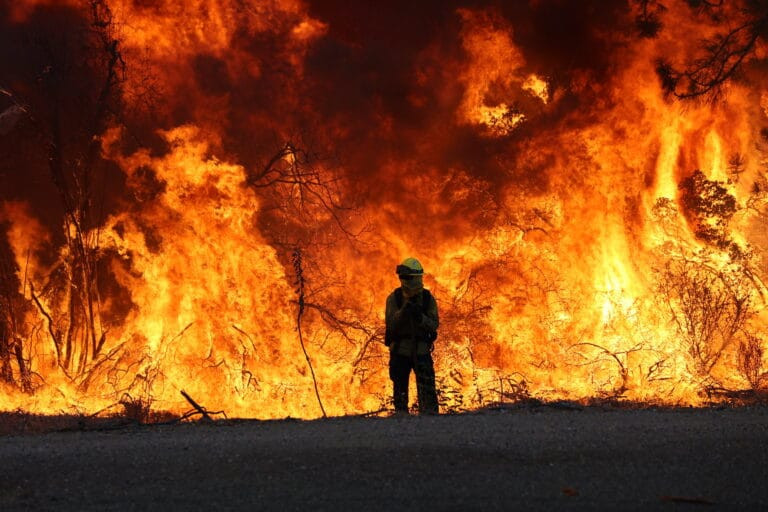As fires rip through Los Angeles County, their widespread devastation is being felt, leaving homes, businesses, and vital lifelines that connect the region to the global economy in ruins. Among the many sectors affected with this crisis, the air cargo industry faces a major test of its resilience and adaptability.
A city ablaze and a global industry shaken
The wildfires raging across Los Angeles have resulted in 25 fatalities, 23 missing persons, scorched thousands of acres, forced mass evacuations, and blanketed the region in a thick, choking smoke. But their impact isn’t just confined to Southern California’s borders. Los Angeles International Airport (LAX), one of the busiest air cargo hubs in the world, has already felt the impact of this disaster.
LAX handles over 2.7 million metric tonnes of airfreight annually, serving as a focal point for goods like fresh produce, medical supplies, and high-value electronics. But with the fires still uncontained and high winds scattering the flames unpredictably, operations are far from business as usual. Thick smoke has reduced visibility, leading to delayed flights, rerouted cargo, and disruptions across the supply chain. The roads and highways surrounding LAX are also jammed or closed altogether.
And this situation could worsen before it improves as fires threaten to spread to industrial zones. A direct hit on these areas could be catastrophic for inventory, facilities, and the goods that power local and global commerce.
Goods at risk: What’s in the air?
What makes air cargo disruptions so significant isn’t just the volume of goods, it’s the items being transported. Some of the most crucial categories of cargo are among the most vulnerable in this crisis:
•Medical supplies and pharmaceuticals: Vaccines, medications, and hospital essentials are shipped via air due to their strict temperature and timing requirements. Delays could mean shortages at a time when access to healthcare is already stretched thin.
•Perishables: Southern California is a global gateway for fresh produce and seafood destined for domestic and international markets. Prolonged delays risk spoilage, impacting both consumers and exporters.
•Consumer electronics: With the holiday season just behind us, businesses are restocking shelves with high-demand products like smartphones and laptops. Delays now could ripple into weeks of supply shortages.
LAX is a major gateway for U.S. trade with Asia trade, a relationship that underpins the global economy. Disruptions here have global implications.
Challenges on the ground and in the sky
For air cargo operators, the challenges are as varied as they are urgent. Significantly reduced visibility caused by the thick smoke has led to flight delays, and necessary air traffic control restrictions are making it difficult to maintain regular schedules. This affects cargo that relies on tight timelines, like e-commerce and perishables.
On the ground, the situation is equally dire. Major highways like the 405 and the 10 are clogged with traffic from evacuations and firefighting efforts. Truckers face delays which slows down the entire supply chain.
Taking into account any cargo handlers displaced by the fires, and the hazardous air quality affecting those that can make their shifts, the workforce has been greatly impacted by this catastrophic event.
Solutions to weather the storm
While the fires are a stark reminder of nature’s unpredictability, they also highlight opportunities for the air cargo industry to adapt and build resilience:
Invest in technology: Real-time tracking and predictive analytics can help carriers anticipate disruptions and adjust schedules on the fly.
Diversify routes: Temporarily using alternative hubs like San Francisco (SFO) or Phoenix (PHX) could mitigate the impact of regional disasters on the supply chain.
Strengthen collaboration: Working closely with government agencies, airport authorities, and emergency responders can streamline crisis management and recovery efforts.
Develop contingency plans: Comprehensive crisis plans that include alternative transportation methods, staffing strategies, and communication protocols can minimise disruptions.
Taking action
Beyond operational adjustments, the industry must also take a look at the bigger picture. Though some may question it, natural disasters are becoming more and more frequent and severe due to climate change, and businesses need to prepare accordingly.
Helping those on the front lines
These fires are a humanitarian crisis and are predicted to be the costliest fires in US history. Thousands have lost their homes, and firefighters are working around the clock to contain the flames.
To support the community, consider donating to organisations like the Los Angeles Fire Department Foundation (LAFD). They’re among the brave “boots on the ground” providing essential equipment and resources to first responders.





